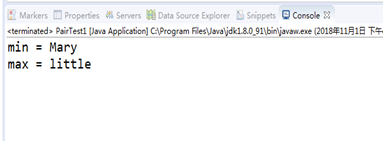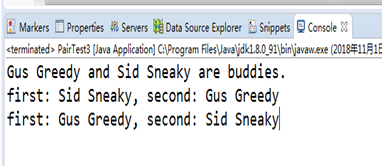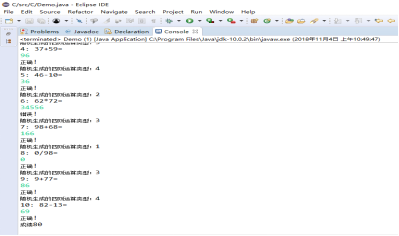201771010135 杨蓉庆《面对对象程序设计(java)》第十周学习总结
1、实验目的与要求
(1) 理解泛型概念;
(2) 掌握泛型类的定义与使用;
(3) 掌握泛型方法的声明与使用;
(4) 掌握泛型接口的定义与实现;
(5)了解泛型程序设计,理解其用途。
一、理论知识
泛型类的定义:
(1)泛型:也称参数化类型(parameterized type),就是在定义类、接口和方法时,通过类型参数指示将要处理的对象型。
(2)一个泛型类(generic class)就是具有一个或多个类型变量的类,即创建用类型作为参数的类。
如一个泛型类定义格式如下:class Generics<K,V>
(3)Pair类引入了一个类型变量T,用尖括号(<>)括起来,并放在类名的后面。
泛型变量的限定:
(1)extends关键字所声明的上界既可以是一个类,也可以是一个接口;
(2)<T extends Bounding Type>表示T应该是绑定类型的子类型。
泛型变量下界的说明:
– 通过使用super关键字可以固定泛型参数的类型为某种
类型或者其超类
– 当程序希望为一个方法的参数限定类型时,通常可以使
用下限通配符
泛型类的约束与局限性:
不能用基本类型实例化类型参数
运行时类型查询只适用于原始类型
不能抛出也不能捕获泛型类实例
参数化类型的数组不合法不能实例化类型变量
泛型类的静态上下文中类型变量无效
注意擦除后的冲突
通配符类型:
“?”符号表明参数的类型可以是任何一种类型,它和参数T的含义是有区别的。T表示一种未知类型,而“?”表示任何一种类型.
这种通配符一般有以下三种用法:
单独的?,用于表示任何类型。
? extends type,表示带有上界。
? super type,表示带有下界。
二、实验内容和步骤
实验1: 导入第8章示例程序,测试程序并进行代码注释。
测试程序1:
l 编辑、调试、运行教材311、312页 代码,结合程序运行结果理解程序;
l 在泛型类定义及使用代码处添加注释;
l 掌握泛型类的定义及使用.
package pair1; /**
* @version 1.00 2004-05-10
* @author Cay Horstmann
*/
public class Pair<T>//Pair类引入了一个类型变量T
{
private T first;//use the type variable
private T second; public Pair() { first = null; second = null; }
public Pair(T first, T second) { this.first = first; this.second = second; }//构造方法的调用 public T getFirst() { return first; }//返回值
public T getSecond() { return second; } public void setFirst(T newValue) { first = newValue; }//入口参数
public void setSecond(T newValue) { second = newValue; }
}
package pair1; /**
* @version 1.01 2012-01-26
* @author Cay Horstmann
*/
public class PairTest1
{
public static void main(String[] args)
{
String[] words = { "Mary", "had", "a", "little", "lamb" };//定义常量
Pair<String> mm = ArrayAlg.minmax(words);//类名调用方法名
System.out.println("min = " + mm.getFirst());
System.out.println("max = " + mm.getSecond());//输出最大值、最小值
}
} class ArrayAlg
{
/**
* Gets the minimum and maximum of an array of strings.
* @param a an array of strings
* @return a pair with the min and max value, or null if a is null or empty
*/
public static Pair<String> minmax(String[] a)//泛型类实例化
{
if (a == null || a.length == 0) return null;
String min = a[0];
String max = a[0];
for (int i = 1; i < a.length; i++)
{
if (min.compareTo(a[i]) > 0) min = a[i];//compareTo比较方法
if (max.compareTo(a[i]) < 0) max = a[i];
}
return new Pair<>(min, max);//实例化后的调用对象
}
}
结果如下:
测试程序2:
l 编辑、调试运行教材315页 PairTest2,结合程序运行结果理解程序;
l 在泛型程序设计代码处添加相关注释;
掌握泛型方法、泛型变量限定的定义及用途。
package pair1; /**
* @version 1.00 2004-05-10
* @author Cay Horstmann
*/
public class Pair<T>//Pair类引入了一个类型变量T
{
private T first;//use the type variable
private T second; public Pair() { first = null; second = null; }
public Pair(T first, T second) { this.first = first; this.second = second; }//构造方法的调用 public T getFirst() { return first; }//返回值
public T getSecond() { return second; } public void setFirst(T newValue) { first = newValue; }//入口参数
public void setSecond(T newValue) { second = newValue; }
}
package pair2; import java.time.*; /**
* @version 1.02 2015-06-21
* @author Cay Horstmann
*/
public class PairTest2
{
public static void main(String[] args)
{
LocalDate[] birthdays =
{
LocalDate.of(1906, 12, 9), // G. Hopper
LocalDate.of(1815, 12, 10), // A. Lovelace
LocalDate.of(1903, 12, 3), // J. von Neumann
LocalDate.of(1910, 6, 22), // K. Zuse
};
Pair<LocalDate> mm = ArrayAlg.minmax(birthdays);//实例化一个LocalDat类
System.out.println("min = " + mm.getFirst());
System.out.println("max = " + mm.getSecond());//得到min、max
}
} class ArrayAlg
{
/**
Gets the minimum and maximum of an array of objects of type T.
@param a an array of objects of type T
@return a pair with the min and max value, or null if a is
null or empty
*/
public static <T extends Comparable> Pair<T> minmax(T[] a) //将T限制为实现Comparable接口的类
{
if (a == null || a.length == 0) return null;
T min = a[0];
T max = a[0];
for (int i = 1; i < a.length; i++)//compareTo方法
{
if (min.compareTo(a[i]) > 0) min = a[i];
if (max.compareTo(a[i]) < 0) max = a[i];
}
return new Pair<>(min, max);//返回新的pair类
}
}
结果如下:
测试程序3:
用调试运行教材335页 PairTest3,结合程序运行结果理解程序;
了解通配符类型的定义及用途。
package pair3; /**
* @version 1.01 2012-01-26
* @author Cay Horstmann
*/
public class PairTest3
{
public static void main(String[] args)
{
//定义Manager类
Manager ceo = new Manager("Gus Greedy", 800000, 2003, 12, 15);
Manager cfo = new Manager("Sid Sneaky", 600000, 2003, 12, 15);
Pair<Manager> buddies = new Pair<>(ceo, cfo);
printBuddies(buddies); ceo.setBonus(1000000);
cfo.setBonus(500000);
Manager[] managers = { ceo, cfo }; Pair<Employee> result = new Pair<>();//程序调用泛型方法
minmaxBonus(managers, result);//泛型方法
System.out.println("first: " + result.getFirst().getName()
+ ", second: " + result.getSecond().getName());
maxminBonus(managers, result);
System.out.println("first: " + result.getFirst().getName()
+ ", second: " + result.getSecond().getName());
} public static void printBuddies(Pair<? extends Employee> p)
{
Employee first = p.getFirst();
Employee second = p.getSecond();
System.out.println(first.getName() + " and " + second.getName() + " are buddies.");
} public static void minmaxBonus(Manager[] a, Pair<? super Manager> result)
//任何泛型Pair类型,它的类型参数是Manager的子类
{
if (a.length == 0) return;
Manager min = a[0];
Manager max = a[0];
for (int i = 1; i < a.length; i++)
{
if (min.getBonus() > a[i].getBonus()) min = a[i];
if (max.getBonus() < a[i].getBonus()) max = a[i];
}
result.setFirst(min);
result.setSecond(max);
} public static void maxminBonus(Manager[] a, Pair<? super Manager> result)//统配符限制为Manager的所有超类型
{
minmaxBonus(a, result);
PairAlg.swapHelper(result); // OK--swapHelper captures wildcard type
}
// Can't write public static <T super manager> ...
} class PairAlg
{
public static boolean hasNulls(Pair<?> p)//泛型类;类型变量的通配符“?”
{
return p.getFirst() == null || p.getSecond() == null;
} public static void swap(Pair<?> p) { swapHelper(p); }
//swap调用swapHelper
public static <T> void swapHelper(Pair<T> p)
{
T t = p.getFirst();
p.setFirst(p.getSecond());
p.setSecond(t);
}
}
Employee:
package pair3; import java.time.*; public class Employee
//构造一个Employee类
{
private String name;
private double salary;
private LocalDate hireDay; public Employee(String name, double salary, int year, int month, int day)
{
this.name = name;//this直接引用
this.salary = salary;
hireDay = LocalDate.of(year, month, day);
}
//访问器方法
public String getName()
{
return name;
} public double getSalary()
{
return salary;
} public LocalDate getHireDay()
{
return hireDay;
} public void raiseSalary(double byPercent)
{
double raise = salary * byPercent / 100;
salary += raise;
}
}
Manager:
package pair3; public class Manager extends Employee//Manager类的父类是Employee类
{
private double bonus; /**
@param name the employee's name
@param salary the salary
@param year the hire year
@param month the hire month
@param day the hire day
*/
public Manager(String name, double salary, int year, int month, int day)
{
super(name, salary, year, month, day);
bonus = 0;
} public double getSalary()
{
double baseSalary = super.getSalary();
return baseSalary + bonus;
} public void setBonus(double b)
{
bonus = b;
} public double getBonus()
{
return bonus;
}
}l
结果如下:

实验2:编程练习:
编程练习1:实验九编程题总结
- 实验九编程练习1总结(从程序总体结构说明、模块说明,目前程序设计存在的困难与问题三个方面阐述)。
package ID;
import java.io.BufferedReader;
import java.io.File;
import java.io.FileInputStream;
import java.io.FileNotFoundException;
import java.io.IOException;
import java.io.InputStreamReader;
import java.util.ArrayList;
import java.util.Arrays;
import java.util.Collections;
import java.util.Scanner; @SuppressWarnings("unused")
public class Main{
private static ArrayList<Person> Personlist;
@SuppressWarnings("resource")
public static void main(String[] args) {
Personlist = new ArrayList<>();
Scanner scanner = new Scanner(System.in);
File file = new File("E:\\新建文件夹\\身份证号.txt");
//捕获代码
try {
FileInputStream fis = new FileInputStream(file);
BufferedReader in = new BufferedReader(new InputStreamReader(fis));
String temp = null;
while ((temp = in.readLine()) != null) { Scanner linescanner = new Scanner(temp); linescanner.useDelimiter(" ");
String name = linescanner.next();
String ID = linescanner.next();
String sex = linescanner.next();
String age = linescanner.next();
String place =linescanner.nextLine();
Person Person = new Person();
Person.setname(name);
Person.setID(ID);
Person.setsex(sex);
int a = Integer.parseInt(age);
Person.setage(a);
Person.setbirthplace(place);
Personlist.add(Person); }
} catch (FileNotFoundException e) {
System.out.println("查找不到信息");
e.printStackTrace();
} catch (IOException e) {
System.out.println("信息读取有误");
e.printStackTrace();
}
boolean isTrue = true;
while (isTrue) {
System.out.println("————————————————————————————————————————");
System.out.println("1:按姓名字典序输出人员信息");
System.out.println("2:查询最大年龄人员信息和最小年龄人员信息");
System.out.println("3:输入你的年龄,查询年龄与你最近人的所有信息");
System.out.println("4:查询人员中是否有你的同乡"); int nextInt = scanner.nextInt();
switch (nextInt) {
case 1:
Collections.sort(Personlist);
System.out.println(Personlist.toString());
break;
case 2: int max=0,min=100;int j,k1 = 0,k2=0;
for(int i=1;i<Personlist.size();i++)
{
j=Personlist.get(i).getage();
if(j>max)
{
max=j;
k1=i;
}
if(j<min)
{
min=j;
k2=i;
} }
System.out.println("年龄最大:"+Personlist.get(k1));
System.out.println("年龄最小:"+Personlist.get(k2));
break;
case 3:
System.out.println("place?");
String find = scanner.next();
String place=find.substring(0,3);
String place2=find.substring(0,3);
for (int i = 0; i <Personlist.size(); i++)
{
if(Personlist.get(i).getbirthplace().substring(1,4).equals(place))
System.out.println(""+Personlist.get(i)); } break;
case 4:
System.out.println("年龄:");
int yourage = scanner.nextInt();
int near=agenear(yourage);
int d_value=yourage-Personlist.get(near).getage();
System.out.println(""+Personlist.get(near));
/* for (int i = 0; i < Personlist.size(); i++)
{
int p=Personlist.get(i).getage()-yourage;
if(p<0) p=-p;
if(p==d_value) System.out.println(Personlist.get(i));
} */
break;
case 5:
isTrue = false;
System.out.println("退出程序!");
break;
default:
System.out.println("输入有误"); }
}
}
public static int agenear(int age) { int j=0,min=53,d_value=0,k=0;
for (int i = 0; i < Personlist.size(); i++)
{
d_value=Personlist.get(i).getage()-age;
if(d_value<0) d_value=-d_value;
if (d_value<min)
{
min=d_value;
k=i;
} } return k;
}
}
Main
程序总体结构:总体分为Main类和Person类
Main类:
1、将人员身份信息导入代码中
2、编辑了查找人员信息的方法
3、分5个case来分别说年龄大小、同乡等消息
Person类:
package ID;
public class Person implements Comparable<Person> {
private String name;
private String ID;
private int age;
private String sex;
private String birthplace; public String getname() {
return name;
}
public void setname(String name) {
this.name = name;
}
public String getID() {
return ID;
}
public void setID(String ID) {
this.ID= ID;
}
public int getage() { return age;
}
public void setage(int age) {
// int a = Integer.parseInt(age);
this.age= age;
}
public String getsex() {
return sex;
}
public void setsex(String sex) {
this.sex= sex;
}
public String getbirthplace() {
return birthplace;
}
public void setbirthplace(String birthplace) {
this.birthplace= birthplace;
} public int compareTo(Person o) {
return this.name.compareTo(o.getname()); } public String toString() {
return name+"\t"+sex+"\t"+age+"\t"+ID+"\t"+birthplace+"\n"; }
}
Person
对各个小模块进行具体的分析
程序设计存在的困难与问题:
1、编写时基础错误还是很多
2、Main类和Person类的变量名有时不能统一
- 实验九编程练习2总结(从程序总体结构说明、模块说明,目前程序设计存在的困难与问题三个方面阐述)。
程序总体结构:Demo主类和Counter类
模块说明:Demo主类
import java.io.FileNotFoundException;
import java.io.PrintWriter;
import java.util.Scanner; public class Demo {
public static void main(String[] args) { Scanner in = new Scanner(System.in);
jf counter=new jf();
PrintWriter out = null;
try {
out = new PrintWriter("text.txt");
} catch (FileNotFoundException e) {
// TODO Auto-generated catch block
e.printStackTrace();
}
int sum = 0; for (int i = 1; i <=10; i++) {
int a = (int) Math.round(Math.random() * 100);
int b = (int) Math.round(Math.random() * 100);
int m= (int) Math.round(Math.random() * 3); switch(m)
{
case 0:
System.out.println(i+": "+a+"/"+b+"="); while(b==0){ b = (int) Math.round(Math.random() * 100); } int c0 = in.nextInt();
out.println(a+"/"+b+"="+c0);
if (c0 == jf.division(a, b)) {
sum += 10;
System.out.println("恭喜答案正确");
}
else {
System.out.println("抱歉,答案错误");
} break; case 1:
System.out.println(i+": "+a+"*"+b+"=");
int c = in.nextInt();
out.println(a+"*"+b+"="+c);
if (c == counter.multiplication(a, b)) {
sum += 10;
System.out.println("恭喜答案正确");
}
else {
System.out.println("抱歉,答案错误");
}
break;
case 2:
System.out.println(i+": "+a+"+"+b+"=");
int c1 = in.nextInt();
out.println(a+"+"+b+"="+c1);
if (c1 == counter.add(a, b)) {
sum += 10;
System.out.println("恭喜答案正确");
}
else {
System.out.println("抱歉,答案错误");
} break ;
case 3:
System.out.println(i+": "+a+"-"+b+"=");
int c2 = in.nextInt();
out.println(a+"-"+b+"="+c2);
if (c2 == counter.reduce(a, b)) {
sum += 10;
System.out.println("恭喜答案正确");
}
else {
System.out.println("抱歉,答案错误");
}
break ; } }
System.out.println("成绩"+sum);
out.println("成绩:"+sum);
out.close(); }
}
Demo
1、判断答案的正确性代码
2、文件的读取
3、四则运算代码的具体呈现
Counter类
public class Counter {
private int a;
private int b;
public int add(int a,int b)
{
return a+b;
}
public int reduce(int a,int b)
{
return a-b;
}
public int multiplication(int a,int b)
{
return a*b;
}
public int division(int a,int b)
{
if(b!=0)
return a/b;
else return 0;
}
}
Counter
四则运算的计算过程及返回值
程序设计存在的困难与问题:
1、数值过大,无法口算
2、运算复杂,不符合基础运算难度
编程练习2:采用泛型程序设计技术改进实验九编程练习2,使之可处理实数四则运算,其他要求不变。
package C; import java.io.FileNotFoundException;
import java.io.PrintWriter;
import java.util.Random;
import java.util.Scanner; public class Main {
public static void main(String[] args) {
Scanner in = new Scanner(System.in);
Suanfa counter = new Suanfa();
PrintWriter out = null;
try {
out = new PrintWriter("test.txt");
} catch (FileNotFoundException e) {
System.out.println("文件夹输出失败");
e.printStackTrace();
} int sum = 0; for (int i = 1; i <= 10; i++) {
int a = (int) Math.round(Math.random() * 100);
int b = (int) Math.round(Math.random() * 100);
int m;
Random rand = new Random();
m = (int) rand.nextInt(4) + 1;
System.out.println("随机生成的四则运算类型:" + m); switch (m) {
case 1:
a = b + (int) Math.round(Math.random() * 100);
while(b == 0){
b = (int) Math.round(Math.random() * 100);
}
while(a % b != 0){
a = (int) Math.round(Math.random() * 100);
}
//若生成的除法式子必须能整除,且满足分母为0的条件,则a一定要大于b,且a模b的结果要为0。
System.out.println(i + ": " + a + "/" + b + "=");
int c0 = in.nextInt();
out.println(a + "/" + b + "=" + c0);
if (c0 == counter.d(a, b)) {
sum += 10;
System.out.println("正确!");
} else {
System.out.println("错误!");
}
break; case 2:
System.out.println(i + ": " + a + "*" + b + "=");
int c = in.nextInt();
out.println(a + "*" + b + "=" + c);
if (c == counter.m(a, b)) {
sum+= 10;
System.out.println("正确!");
} else {
System.out.println("错误!");
}
break;
case 3:
System.out.println(i + ": " + a + "+" + b + "=");
int c1 = in.nextInt();
out.println(a + "+" + b + "=" + c1);
if (c1 == counter.add(a, b)) {
sum += 10;
System.out.println("正确!");
} else {
System.out.println("错误!");
}
break;
case 4:
while (a < b) {
b = (int) Math.round(Math.random() * 100);
}
//因为不能产生运算结果为负数的减法式子,所以a一定要大于b。若a<b,则重新生成b。
System.out.println(i + ": " + a + "-" + b + "=");
int c2 = in.nextInt();
out.println(a + "-" + b + "=" + c2);
if (c2 == counter.r(a, b)) {
sum += 10;
System.out.println("正确!");
} else {
System.out.println("错误!");
}
break;
}
}
System.out.println("成绩" + sum);
out.println("成绩:" + sum);
out.close();
}
}
Main
package C;
public class Suanfa<T> {
private T a;
private T b;
public int add(int a,int b) {
return a + b;
} public int r(int a, int b) {
return a - b;
} public int m(int a, int b) {
return a * b;
} public int d(int a, int b) {
if (b != 0 && a%b==0)
return a / b;
else
return 0;
}
}
Suanfa
结果如下:


三、总结如下:
本章我们学习了泛型程序设计技术,首先理解了泛型概念,掌握泛型类的定义与使用,泛型方法的声明与使用,最后感觉了解泛型程序设计及其用途,在验证实验中,通过对代码的解读,更深的学习了泛型程序<T>的使用,还复习了实验九的两个编程题目,感觉依旧存在些小问题,在接下来的实验中要更好的解决,编程实验中,在实验九的四则运算基础上,加入了本章泛型程序的概念,虽然不是很熟练,但还是勉强做出来了。
最新文章
- SQLServer事务
- SQL.WITH AS.公用表表达式(CTE)
- javaweb学习总结(八)——HttpServletResponse对象(二)
- 【转载】一步一步写算法(之hash表)
- mac os x使用Git简易入门教程
- RMAN备份与恢复之DataBase
- AJAX_1
- 网站eurl.axd报错的解决方法
- echo & print
- WinForm触摸屏程序功能界面长时间不操作自动关闭回到主界面 z
- HTML&CSS基础学习笔记1.16-单元格间距和表格主体
- webService 客户端接口调用【java】
- php非阻塞
- js中原生对象、内置对象和宿主对象(转)
- 【转载】CANoe 入门 Step by step系列(三)简单例子的剖析
- [转载] Hadoop MapReduce
- Litepal【开源数据库ORM框架】
- CSS 基础:文本和字体(4)<思维导图>
- cocos2d-x JS 纯代码加载播放plist与png动画
- nth-child与nth-of-type区别